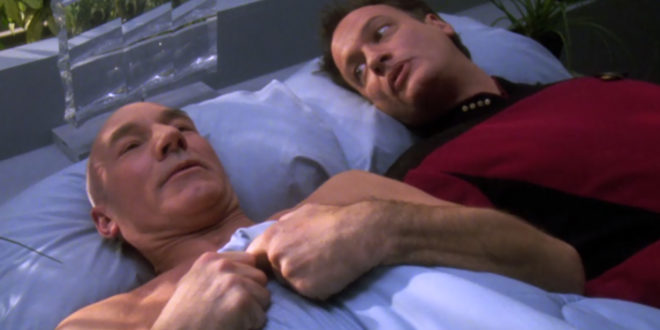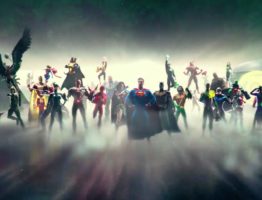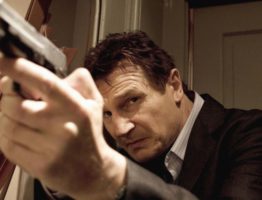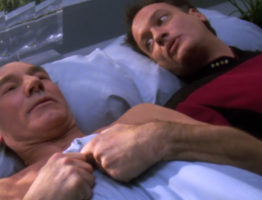Welcome to the second part of this definitive ranking of TNG‘s serialized plots. I am Fergus The Justifier, your guide through this fascinating endeavour. For a refresher on how we got here, here’s a link to part one.
As before, the criteria are varied and complex, involving pure entertainment factor, degree of originality/innovation and importance to the show’s overall success/development.
One of the best comments I received from the first post said “So you just hate Star Trek then.” I could only guffaw and stab my sword into the ground with much hilarity and mirth! Quite the opposite – I love Star Trek and ST:TNG.
I was hooked on TOS before I could talk. Two more noble and thought provoking shows have never been broadcast. However…I am an intelligent man of good taste. I am not unable to discern sh*t from wit, nor mold from gold. TNG had a lot of flaws, especially early on. So many flaws…
As a sworn enemy of all things Terrible, it is both my curse and my duty to report the truth and strive for the better. But now that most of the Rigellian star-chaff is out of the way, we can finally get into some of the better sustained narratives of TNG. There’s still some soap opera slime to get through before we get there, however, so let’s get this party started.
Onward for glory!
10. Geordi Sucks With Women
Yes he does. Oooooh yeah. He really does.
God, the character of Geordi Laforge. So tough to love him. From day one, with his ridiculous “Wooo-wee’s!” and awful dialogue, Geordi just seemed totally indicative of the “non-threatening black male” – a trope all too common in Hollywood.
Unfortunately, as the series progressed, we discovered that no, Levar Burton is just actually really like that – and not much of an actor. Sorry Geordi fans (do you actually exist?).
As with any long-running show, the line between character and performer began to blur (God, by the end of M*A*S*H it was just Alan Alda and Loretta Switt hanging out in a tent, just playing themselves). So I can only assume Geordi’s having zero game with women arose from the writer’s direct observation of Levar Burton hitting on some poor extra.
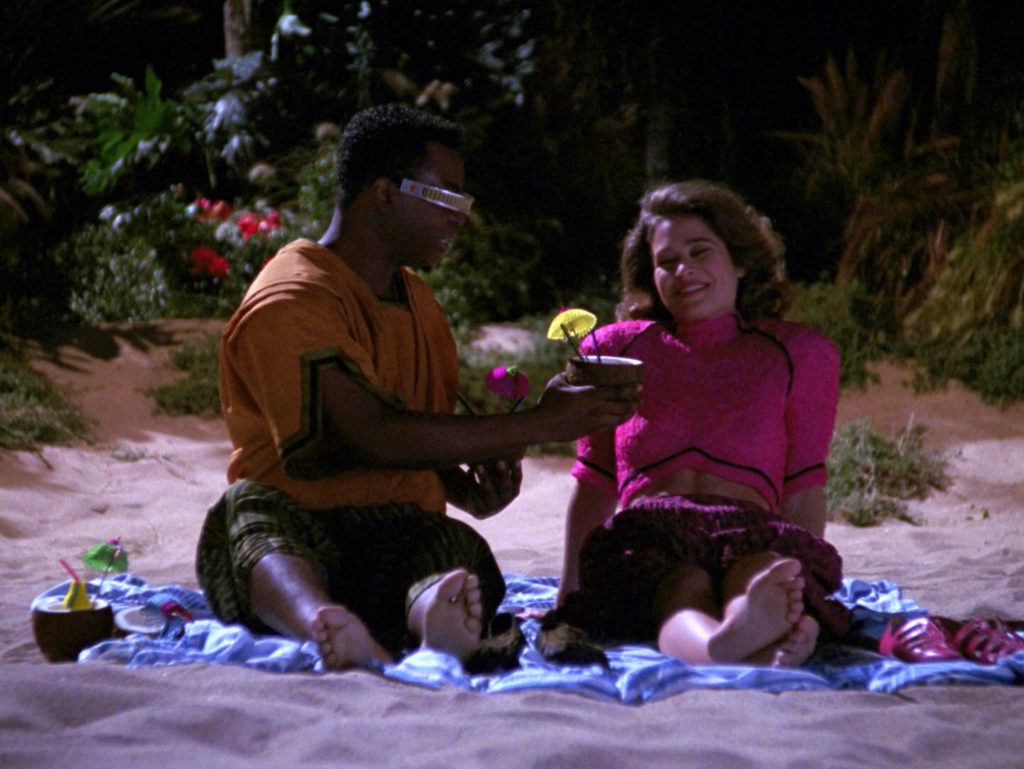
This cringe-inducing character narrative basically gave us two more full episodes centered around Geordi’s pathetic love life, in which he crashes and burns in true Three’s Company fashion. I’ve scored this at number ten because as lame as this character trait is, it’s still one that most people remember – and the episodes that intersect with Geordi’s romantic shenanigans actually score quite high on the sci-fi meter (alien booby traps, Jesus alien and giant baby space alien).
Once again, we see how the writers took a simple character trait and expanded it into a serialized motif that began to influence and shape the plots of the week.
References to Leah Brahms would pop up several more times during the run of TNG – most notably in the series finale, “All Good Things” – where we learn they get married! And have kids! Continuity! Wooo-wee!
As a side note, I recently had a conversation with WOT’s fellow viking-geek, Gorp the Malcontent, that lead to a startling epiphany. I had always assumed that the future timeline depicted in “All Good Things” was just an elaborate construct of Q’s, as the whole Geordi/Brahms thing, and the Riker/Enterprise thing, were just too “perfect.” Like, no way! So, this had to be a version of the future created by Q, right?
BUT THEN…we were discussing how when Levar Burton flies he probably needs an extra seat for his Reading Rainbow emmy’s, which I assume he takes with him everywhere – because as one of his crazy twitter storms reveal, the guy is a grumpy flier who needs extra seats when he takes to the air.
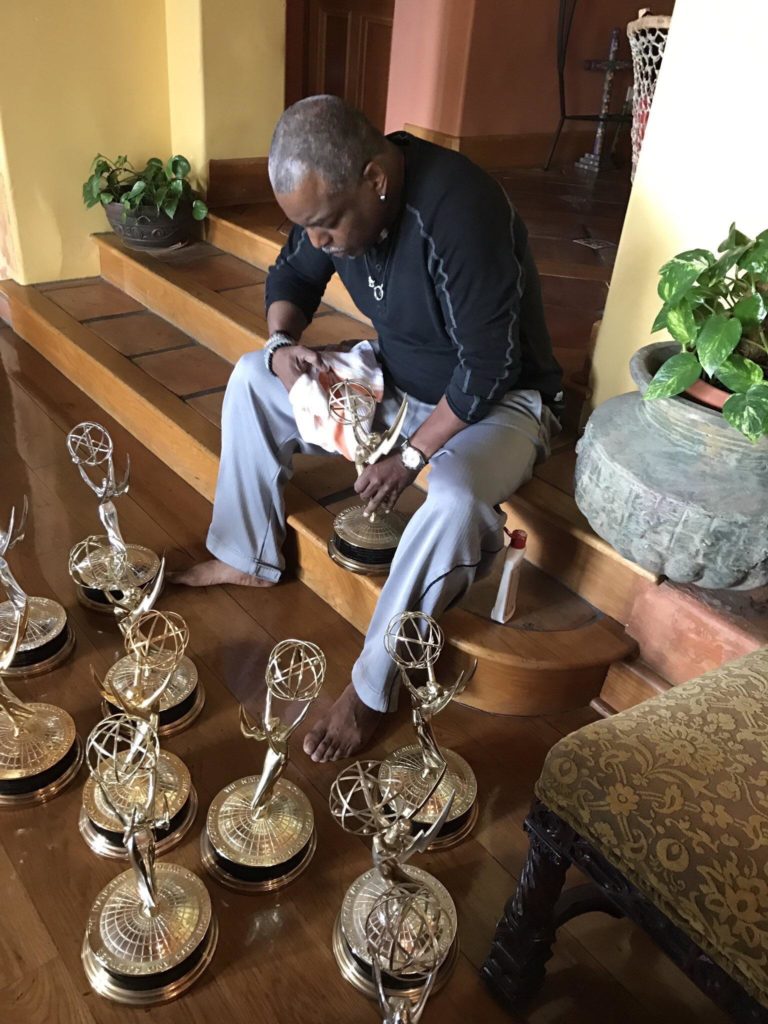
So naturally we decided that the second first class seat mentioned in his twitter rage would be for Leah Brahms’ hologram. That’s when it hit me like a tonne of Tarkassian star-bricks – f**king Geordi married the goddamn hologram! The future shown in “All Good Things” is real, y’all!
Of course Geordi married the holo-version of Leah Brahms! DUH! And had holo-kids (or maybe adopted, not sure)! By the time of TNG, I’m sure holo-romances and holo-wives are totally common and accepted as the norm. Especially for geeks like Geordi and sex maniacs like Riker. Riker is clearly a big fan of holo-relationships and holo-sex (“I’ll be in holodeck four”), so this all just makes perfect, horribly sad sense.
Anyway.
Love his lack of game or loathe it, you can’t deny it added further dimension to the character. Which, IMO, was desperately needed. Good dimensions would have been preferred, however.
9. Tasha Yar’s Death & Her Sister & The Enterprise-C & Sela & Jes*s Chr**st Make it Stop Already
Note to actors on TV series: if you choose to leave a show, or if you are fired or depart over “creative differences” – then stay gone! Please! F**king Denise Crosby and Goddamned Wil Wheaton! They’re like fruit flies in summer! You can’t get rid of ’em!
Gah, where do I even begin with all of this? (Sigh) I guess at the start. Well, obviously Denise Crosby said “fuck it, this show ain’t going anywhere, peace out,” and split. You can’t blame her thinking at the time. First two seasons = unwatchable train wreck. So they killed her dead. Cool.
This was actually the first TNG event that made people sit up and take notice. Her death episode, “Skin of Evil,” felt more like old Trek, which sorta felt better? Kinda? At least at first. The Tar Monster was definitely old Trek.
Now in hindsight we can see just how wrong this approach was. TNG needed it’s own unique voice and that didn’t happen until later in this list (no scrolling!).
Tasha’s death was certainly must-see TV, however – even if the manner of her death totally blew. Could she have fired her phaser at least?
No main character had ever died on a Star Trek TV series before. The closest the old show had ever come to a series regular’s demise was the death of Walter Koenig’s self-respect when he had to wear the Beatles wig. The ramifications were huge for the show – just not right away.
Unlike other serialized plots on TNG, this one took the writers a while to get to. Once they got a taste for it, however, they feasted upon the carcass of Tasha Yar like zombies on crack, gorging themselves over and over then regurgitating her narrative remains endlessly throughout the show’s remaining seasons. From Memory Alpha:
-
Ron Moore noted, “We brought Denise back to kill off Tasha Yar a second time. It was a great opportunity to send the character off in a big heroic sacrifice because nobody was really happy with the way she left the series in the first season. Nobody on the show really liked it, the fans didn’t like it, I’m not sure even she really liked it. So ‘Yesterday’s Enterprise’ was a chance to kill her right.” (Chronicles from the Final Frontier, TNG Season 4 DVD special features)
I’m sure this was all spurred on behind the scenes by Denise herself, as the show began to improve and she felt the searing pangs of horrible, gut-wrenching regret. Also – her movie career fizzled.
…following a conversation with Denise Crosby at a convention, Eric Stillwell developed a story (along with Ganino) that would allow Tasha Yar to return to the series after a two-year absence.
Yup. Knew it. Clandestine conversations at conventions – the age-old sci fi actor’s maneuver.
Of course it only made sense to mention Tasha from time to time, as in “Measure of a Man,” but then we got to “Yesterday’s Enterprise.” Oh wow, Tasha’s back, look at that. Hmm. Can we keep her and get rid of Worf permanently?
“Yesterday’s Enterprise” was fantastic – but the seeds it planted in the past were not. Those seeds were worse than the seeds of an Arcturian stink-vine.
Alternate timeline Tasha was a great idea. What better way to establish this new and slightly different reality? If only they had just left it there. So then we get Tasha’s sister. Okay, small galaxy, but whatever. Then comes…the mystery figure in the dark. Like, a literal “ominous person concealed by the shadows.”
Baaaaaaaaaaahhhhhhhhwwwrrrrrrrffff.
Seriously, TNG?! Once again the show deviated far, far into the soap opera neutral zone. Yet another variation on the “evil twin” motif, this little surprise stretched the limits of believability like a Tarcarian Stretch Armstrong. She should have been given a cape and a moustache to twirl!
The character of Tasha’s identical twin daughter just did not work, no way, no how. You can get away with this sh*t in comic books but not on TV. Not unless your opening has an hourglass in it.
The time travel aspects of Sela’s creation and Picard’s dealing with the surprise are mildly interesting, but the character is just ridiculous through and through. They could have at least made her wig black. Oh well.
Characters like Sela are usually the product of rampant fan fiction…or out of work actors:
Crosby stated, “the part of Sela sort of came about from me sitting around in my house one day thinking about how much fun it was for me to go back and do “Yesterday’s Enterprise“, and it was so much fun that I thought what else can I do? I thought it was pretty well established that Lt. Yar and Lt. Castillo on “Yesterday’s Enterprise” had something going so perhaps they had a child or Yar was pregnant when she went back into the past to fight her final battle. And I sort of thought it out and it seemed to really make sense, and there were no flaws.”
“So my original intention was that Lt. Yar would have a daughter that was raised by Romulans and would grow up to try to actually be a Romulan. So I brought this up and the producers really liked the idea and they sort of toyed with it for a while. A few months went by and I got a call and they said we like your idea but we just can’t make sense of that Lt. Yar got pregnant by Castillo. We’ll have it so that Yar was captured, they didn’t all die in the battle, the ship was captured and she was taken by a Romulan general.” (Trek: The Next Generation Crew Book)
Seriously, was Denise Crosby dating a producer or a writer or something? Or were the show runners just hypnotically mesmerized by the divine talents of Denise Crosby, our generation’s greatest thespian? How did she swing it? Blackmail? We may never know.

So this endless chain of events resulting from Tasha’s death ranks at number nine – but only because so many damn episodes were haunted by the spectral reach of her undying influence.
Hey Denise – maybe Sela also had an identical daughter who could travel back through time to meet the crew of Discovery? She could be in league with the grandson of Noonian Soong and the disembodied consciousness of Lore.
I have to stop there because it’s too depressing. You can’t even laugh at such absurd speculation because they’ve already done this kind of sh*t. Discovery will get there, you’ll see. Y’know, it’s not a crime to be critical of fan-service writing like this. C’mon people, wake up!
8. Picard’s PTSD (Ressikan Life)
God damn, but does Picard end up carrying some heavy baggage. God damn.
As if the Locutus incident wasn’t bad enough (still to come!), he has this to deal with. Note to sci-fi writers: the best sci-fi involves time – lots and lots and lots of time. Even an hour long TV show can tackle epic concepts. Why not do stories that span an entire lifetime? Or longer? It’s sci-fi! You can do whatever you want – swing for the fences! Stephen Moffet loves this shit. Rory’s “Last Centurion” arc and that episode where the Doctor is trapped in a time loop for millennia are perfect examples.
“The Inner Light” has to be considered the best episode of TNG. It’s almost perfect. I appreciate it more every time I see it.
The last time I watched it, I noticed a detail concerning his smile at the end of the episode that I had never caught before: as Picard is led to the turbolift upon “returning” to the Enterprise, he instinctively raises his right hand to touch the area where a Ressikan door mechanism would be – and he smiles upon realizing there isn’t one, and that he is really back home (this is perhaps the only false note in the episode, as I doubt this guy would be capable of such mirth after being so royally mind-f**ked).
-
Ronald D. Moore commented, I’ve always felt that the experience in ‘Inner Light’ would’ve been the most profound experience in Picard’s life and changed him irrevocably. However, that wasn’t our intention when we were creating the episode. We were after a good hour of TV, and the larger implications of how this would really screw somebody up didn’t hit home with us until later (that’s sometimes a danger in TV – you’re so focused on just getting the show produced every week that sometimes you suffer from the ‘can’t see the forest for the trees’ syndrome). We never intended the show to completely upend his character and force a radical change in the series, so we contented ourselves with a single follow-up in “Lessons“. (AOL chat, 1997)
That follow up – though brief – is what elevates this narrative to an important bit of TNG serialization. The scene where Picard reveals his Ressikan flute is almost shocking. Such moments of real recognition and call-back awareness are rare in TV. So often we get the dreaded “fake back story” for such scenes, where we have to endure a character re-telling some memory made up by the writers to illustrate a theme.
Despite Picard’s fake-ass flute-playing, knowing the devastating backstory of Picard’s Ressikan flute from having actually witnessed it with our own eyes truly imparts a very real and impactful gut punch when he shares his playing with Lt. Commander Daren.
And I do like my sci-fi with gut punches.

7. Picard’s PTSD (Locutus)
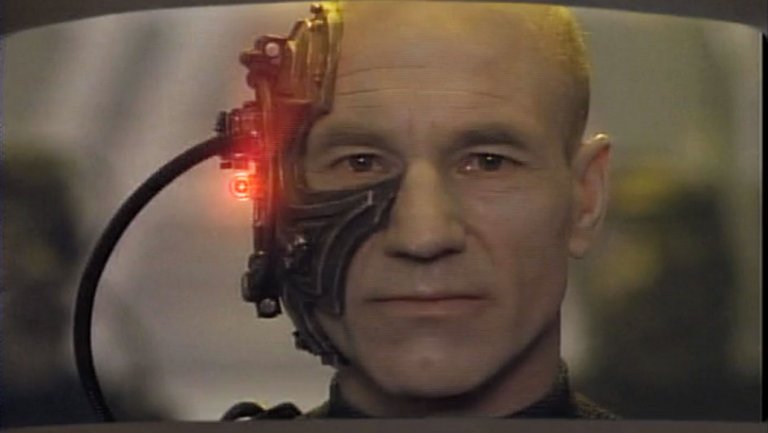
Locutus of Borg was an inspired creation – one that certainly kept the fans guessing. In terms of the show’s reality and Picard’s character, surviving Locutus was a fate worse than death.
Next to Worf’s discommendation (was this word made up just for the show?), this is the one continued narrative that made the most sense for the series. All the romantic sub-plots and cutesy character trait narratives are fine, I guess, but this insane twist was a true violation of Picard’s psyche – with horrible, tragic consequences. Unlike the events of “The Inner Light,” this was an experience you could never truly learn to live with.
So the writers were absolutely correct to fight for their right to further explore Picard’s trauma. The old days of TOS, in which a character could endure unspeakable tragedy – and then show up for next week’s episode completely reset to normal – were long over (the closest TOS ever got to depicting such emotional strife was the end of “Requiem For Methuselah,” where they used the perfect cheat – Spock using a mind-meld to wipe the grief from Kirk’s mind).
You could always invoke “TV logic” and say “well, the next episode actually takes place several months later,” but I respect the show’s choice to deal with Picard’s PTSD head on. And how!
“Family” was the result, an episode I consider to be among the best the show ever produced (aside from the Wesley BS). Airing right after “Best of Both Worlds,” this episode is like a futuristic version of “The Taming of the Shire” from LOTR – we are shown that nothing will ever be the same again. Not for Picard, nor for the Federation.
Not only do we get a refreshing glimpse into a non-Starfleet life in the 24th century, we also get one of Patrick Stewart’s finest performances – perhaps of his entire career. The pain he imparts relentlessly continues the horror of “The Best of Both Worlds” – all with nary a borg in sight. Aftermath. Consequences. These were still a novelty for an episodic sci-fi TV show.
Picard’s lingering trauma is referenced many more times, to dramatic effect. While this definitely gave Picard an added edge and kept the terror of the Borg alive in viewers’ minds, the Borg themselves unfortunately got super laaaaaaame, super fast. The only worthwhile element of “I, Borg” is watching Picard’s inner conflict with his Locutus past and trying to accept Hugh as an individual. Everything else to do with that episode is “bored-writer-bullsh*t.”
They didn’t need to use the Borg again until the movies. Instead they chose to drastically humanize the show’s most alien and menacing adversary. As with Spock in TOS, sometimes Star Trek just can’t allow aliens to be, well…alien.
I know they were trying to pull a “horta” and be all Star Trek and everything, but you should be able to respect the Borg as a life form without turning them into a CW character. Or not. A real human being would have flushed Hugh into space. The character of Captain Picard, however, is instead allowed to overcome his PTSD and thus personify the ideal tenets of Star Trek – which is for the best, I suppose.
6. Riker/Troi
Regurgitated hold-over from Phase II and TMP. Unwieldily sub-plot that the writers had no choice but to leave unresolved until literally the last, dying gasps of TNG. The door to some truly horrid and embarrassing moments.
For some reason Roddenberry loved this character dynamic so much that he just had to use it twice. It is a good angle, to be sure. But that still doesn’t mean you get to use it twice. You already stole Goldsmith’s damn theme from TMP for TNG!
Welp, he went ahead and baked this re-heated leftover into both the pilot and the show bible and so we all got stuck with it for seven seasons. Riker and Troi’s dynamic was all hot and heavy at first, then of course the writers had to cool it off and have them hook up with other people and holo-characters. Which did lead to some interesting character moments for each of them.
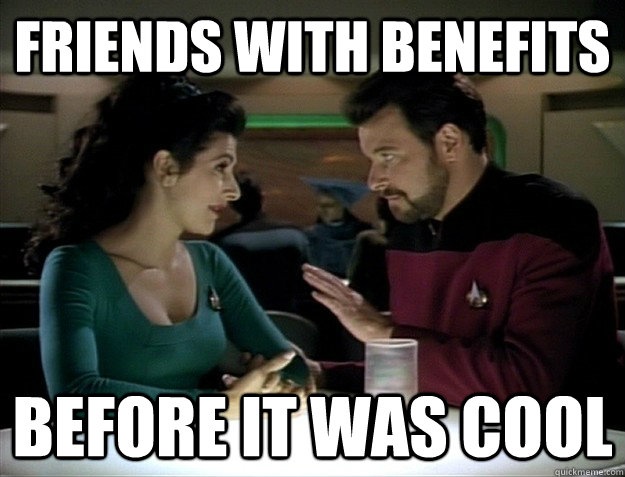
But make no mistake, a will-they-or-won’t-they former lovers angle? This is pure, one hundred percent soap opera right here. And it’s not the only one! There’s still Crusher and Picard as well.
When they first announced a new Star Trek, never in my wildest imaginings did I envision these kinds of sub-plots would be so prominent in my space adventure show. Don’t get me wrong – if a show is gonna go seven seasons in the 80’s, then serialization is pretty much required to keep things interesting and realistic. But I blame the Riker/Troi thing for THIS:
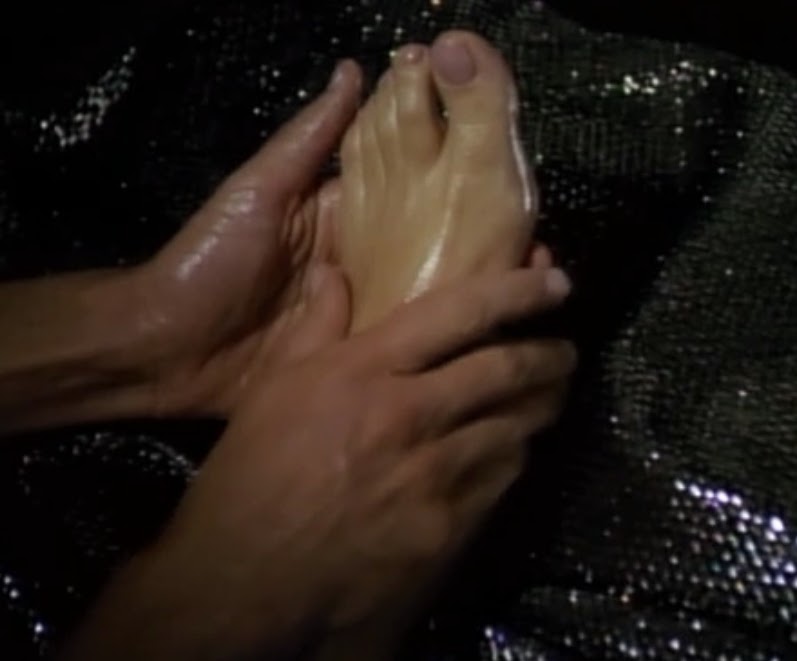
DEAR GOD! Are those feet even human?! I mean, she’s supposed to be playing an alien but I think those are her real f**kin’ feet! Look at that big toe! Look at the skin tone! Was Troi’s DNA always regressing into a toad-woman? A backwards time-paradox plot that got abandoned? I hope the guy playing her lover had a stunt double do this scene, because your guest star wages do not cover touching those feet.
This is right out of Days of Our Lives. So much to do with Troi and Crusher bordered right on the edge of sexist daytime TV pap: chocolate fetishes, yoga classes and gossip. FOR SHAME. Seen with modern eyes, these things are cause for serious eye-rolling.
Once you open the door to romantic, soap opera serialization like the Troi/Riker dynamic – even if just a crack – you must be ever on guard for this type of dramatic abomination. Especially on a plot-hungry show like Star Trek. Personally, I like my sci-fi adventure shows without f**king foot massages. Even the cheap and tawdry decontamination rub ‘n tugs of Enterprise made more sense than this.
Oh yeah, back to Troi and Riker. Well, their love story was certainly a load-bearing pillar of the series, by virtue of being introduced right from the start and continually re-visited throughout the entire run of the show. So many episodes dealt with their submerged and/or restrained feelings for each other. Sometimes interesting (“Second Chances”). Sometimes dreadful (“Ménage à Troi”).
Neither god awful nor particularly thrilling, this continued character narrative added some extra layers without ever becoming unbearable – until Insurrection/Nemesis.
5. Worf’s Son
The most surprising serialized plot-line of the show had to be the ever-changing dynamic between Worf and his son, Alexander. Who knew that Worf’s perfect role was as “Comedy Relief Dad?”
Seriously, Worf never truly clicked as a proper Klingon warrior – Dorn’s “try-hard” performance and his horrible bob-wigs saw to that. By the end of the series the character could pass for a true Klingon warrior, I suppose, as Dorn finally relaxed and figured things out – but I believe the character only really came into his own with the introduction of Alexander.
This was no accidental discovery of Dorn’s comedic side. I find it incredibly fascinating that the show chose to go for comedy almost right away with these two. If the writers had really intended to create a true “Klingon” dynamic between them, Alexander would never have been so damn cute. I mean, he looks like he just stepped off of the set of Eight is Enough or Family Ties. Oh sh*t – he did!
No, the writers eschewed a more realistic portrayal of what a Klingon parent/child relationship would really be like and went for straight up laffs and yuks with this very humanized dynamic, turning our favourite Klingon warrior into a hopelessly lost, disgruntled single parent. All for our amusement.
But like a Reese’s peanut butter cup – it worked! HA!
Soon the writers were using Worf in all kinds of laugh-track ready moments (“I am NOT a merry man!”) and putting him in westerns and sh*t. As a comic foil, you can’t beat a Klingon. Just ask William Campbell!
I feel the importance of this serialized arc cannot be overlooked. For the first time a bridge officer was shown to have a child living with them on board (not counting Deanna’s weirdo alien baby), which definitely shook things up.
This new dynamic gave Worf’s character a whole new life and upped the jeopardy and emotional quotient of several episodes – Worf might not care about dying himself (boring), but he’d do anything to save and protect his son (better).
Who knows, this more “family-friendly” approach to Worf may have even roped in some new viewers to Star Trek. Like grandmothers. The kid was dang cute.
4. Worf’s Discommendation/The Klingon Civil War
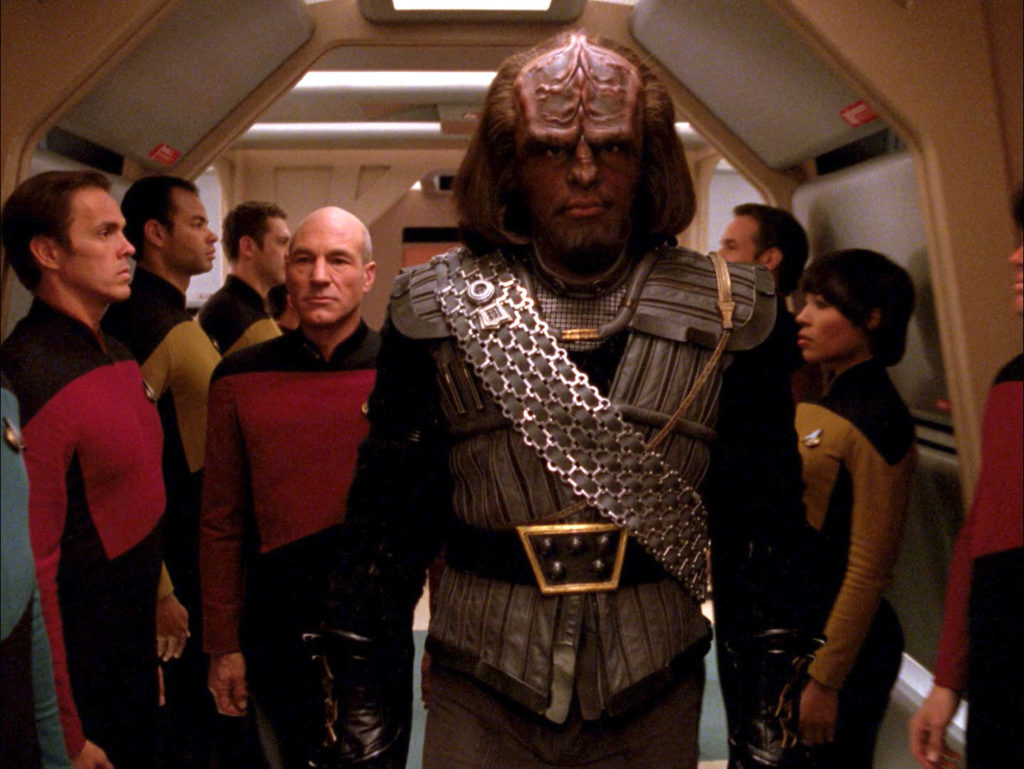
If the Q sub-plot retroactively gave the series a narrative spine (you know it’s coming), and the Borg sub-plot finally helped give TNG it’s own identity (no scrolling ahead!), then the whole “Worf-is-fired-from-the-Klingons-but-it’s-on-purpose-for-honour” narrative is how the writers officially announced to the world “hey, we’re going full soap opera here!”
If you read any account of the writer’s room on TNG, you always hear the same refrain, over and over: “Woe is us! Gene never lets us have dramatic tension between the crew characters, boo hoo hoo.”
Bah. Morons.
TV writers just can’t accept that certain things are inherently baked into Star Trek‘s DNA. As DS9, Voyager, Enterprise and now Discovery have all proven, you can’t really f**k with the recipe of Star Trek too much before the cake collapses and you’re just doing Battlestar Galactica.
Anyway, I digress. In an attempt to free themselves from the shackles of their frustration and boredom, they decided to officially introduce a more serialized approach to the show.
Moore saw this episode as a turning point towards more continuing story arcs on The Next Generation. He commented, “The biggest decision on this show was the ending…where Worf takes it on the chin and decides to accept his dishonor even though he knows its a lie but he does it for the greater glory of the Empire and he walks out the door and it ends with this sense of ‘Oh my God. This has changed Worf forever, and what’s going to happen to him next?’ And what that did to the franchise overall was it suddenly said there’s a continuing story here…
As soon as Worf walks out the door with his dishonor it demands a follow-up. And that’s why we eventually came back to “Reunion” and “Redemption” and on and on and on. All the Worf stories spring from that moment, and also opened up the whole franchise to the idea that maybe we can do continuing stories. It was really a pivotal moment looking back on how we structured Next Generation.” (Chronicles from the Final Frontier, TNG Season 4 DVD special features)
So yup, TNG actively embraced serialized arcs after all this Klingon jazz. Even though the logic of the whole thing is really…screwy. I mean, I always felt that a Klingon would rather burn it all down – their whole society, their house, everything – rather than face dishonour. They love war and combat and glory and dying on good days and are only happy in battle. So why the f**k avoid a chance to initiate the Klingon Ragnarok? I mean, when the civil war finally happens anyway, all the Klingons are just as happy as can be. So like, WTF, Worf?
I Know you could say “well, he did it to save his brother,” but to that I call bullsh*t. I think they’d both rather die than remain alive through dishonour.
Anyway, this arc is certainly enjoyable and represents some of TNG‘s most watchable episodes.
The best thing to happen out of this storyline, though? KURN.
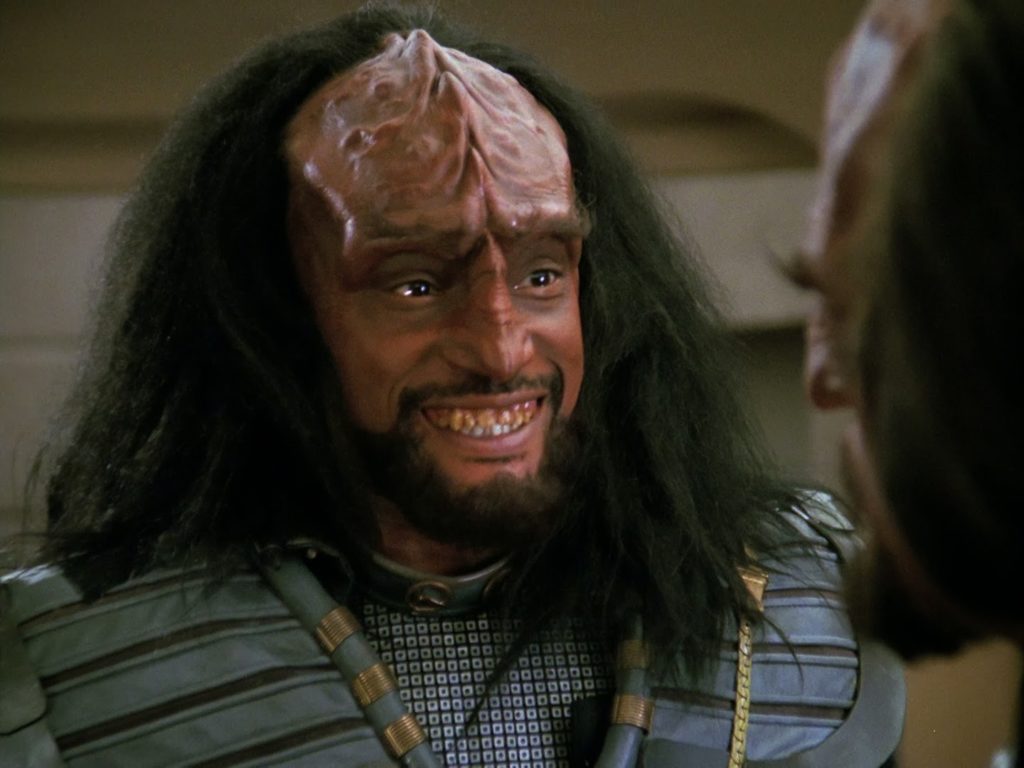
KURN!!!
Jes*s Chr*st, thank you – finally a real Klingon! Kurn’s scenes in “Sins of the Father” are a true pleasure. So, so great. The guy shows up Michael Dorn like crazy.
Dorn’s performance always smacked of trying too hard to act “Klingon.” His “serious warrior” intonation felt so forced.
Kurn just is a Klingon. He actually comes across as an actual Goddamn alien. I mean, can you imagine the series if we had been given a Klingon like Kurn instead of Worf? Gah. It’s painful to contemplate the glory of that what-might-have-been.
3. Data’s Quest
Unlike Spock’s struggles with suppressing his human half – which was just sort of a constant character trait, only occasionally touched upon – TNG developed Data’s arc by actively focusing on his varied and evolving attempts to become more human and understand humanity.
Things such as painting, acting, dating, pen-paling, dreaming and fornicating in wild and inhuman positions were constantly weaved into the plots – often serving as a handy means for commenting on the human condition. A robot’s attempts at becoming more human ultimately teaches us what it truly means…to feel. So profound.
As with the many appearances from Q and the Q Continuum, Data’s serialized quest provided the show with another solid thematic stress-ball to squeeze and squeeze, over and over.
Ronald D. Moore: “Can you think of any b-plots this week?”
Bryan Fuller: “No. Can you?”
Ronald D. Moore: “No.”
Bryan Fuller: “Have we done ‘Data programs himself to get a cavity’ before?”
Ronald D. Moore: Let’s type it up.
With very little progress to show for all of his efforts, the bits started to get old – especially when played mainly for laughs. Data has a cat, BAHAHAHAHA! Data learns to dance! Although, I have to admit, this moment truly worked:
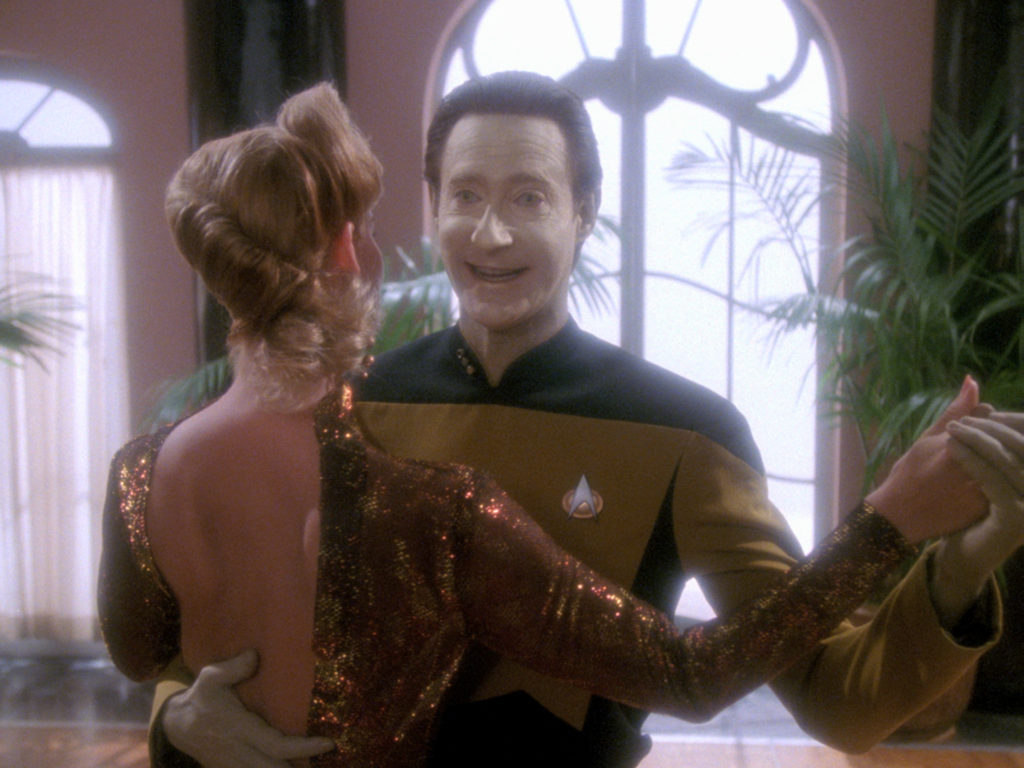
The final shot from “In Theory” – Data sitting alone with his cat, Spot, after his romance experiment fails – perfectly succeeds in poignantly depicting the isolated and emotionless existence of an android (nice job by director Patrick Stewart).
By the time they got around to introducing his emotion chip, however, no one really cared anymore. In fact, after Brent Spiner’s over the top mugging in Generations, nobody ever wanted him to use the damn chip again.
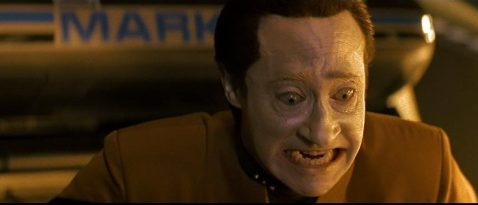
There’s no argument Data was probably the most popular character, next to Picard. As a result, his arc certainly helped define the show. But he represents such a missed opportunity.
Before the show aired, I always remember hearing that the android character on the Enterprise-D was to be a representative of an alien race curious about learning more about Starfleet. “Data.” Collects…data. Makes sense. Could this have been yet another hold over from the aborted Phase II? Or a re-working of Ilia from ST:TMP? (By the way, all you writers and bloggers out there, ENOUGH with the Phase II/TMP articles – every damn week I come across one – we all know everything about it now and there are already 239 articles to choose from). I personally believe it was ripped off from an old Marvel Comics Hercules mini-series.
This is an angle I would have much preferred, rather than the increasingly bizarre and convoluted weird-o origin we got instead. Perhaps the writers felt this would have been too similar to Ilia in ST:TMP. Perhaps they were already envisioning Brent Spiner chewing up the sets in multiple roles related to Data’s family. Whatever the reason, we as viewers received something much more mundane and silly.
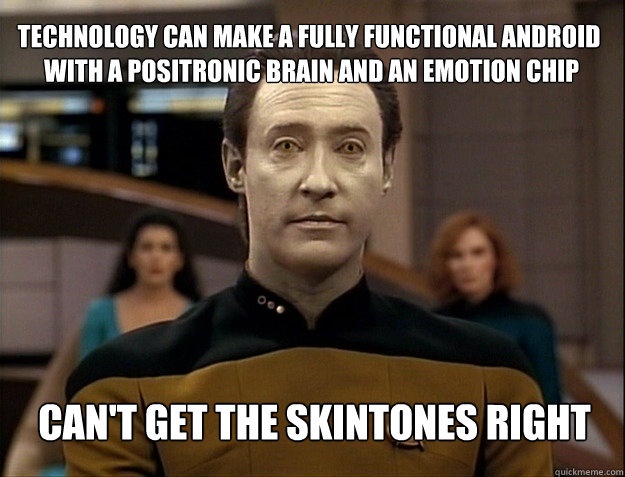
2. The Borg
Today, people tend to forget that the first two seasons of TNG were wretched, laughable travesties of un-endurable drek where the acting appalled and even the costumes and lighting made you wanna recoil in disgust.
Two seasons in and the show had yet to find its voice. Wesley Crusher featured heavily in every storyline and was the only character capable of saving the day. Geordi let loose with “Woooo-wheeee’s!” Most of the planets were populated by either naked hedonists or offensive stereotypes.
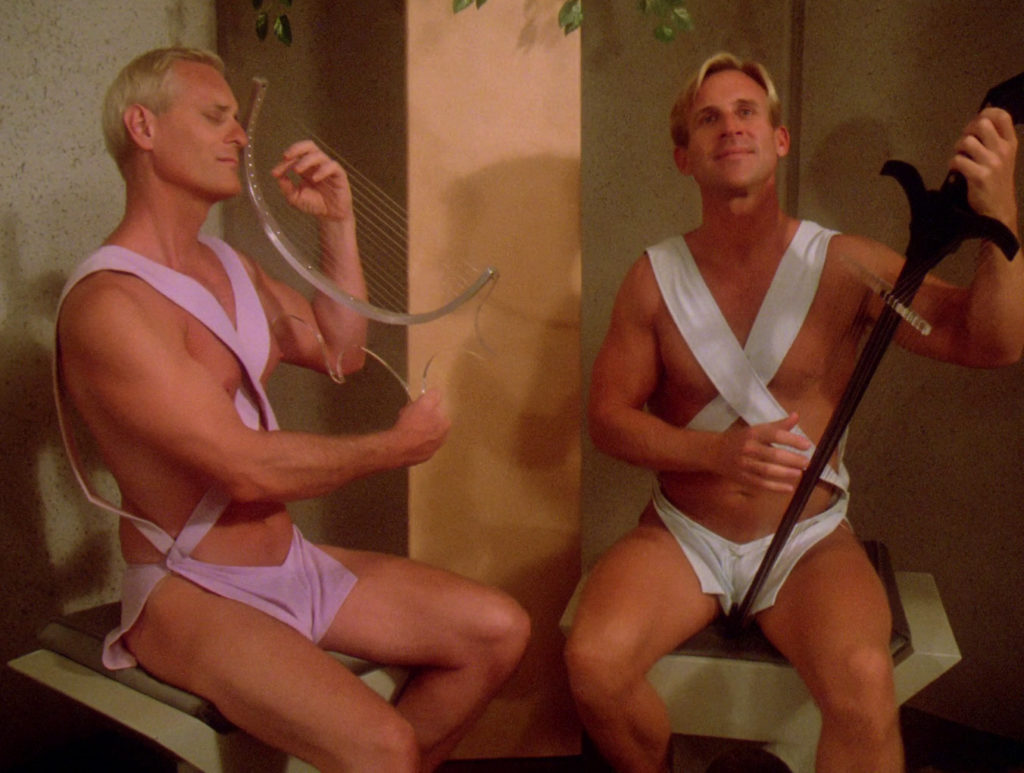
Enter the Borg…and everything changed.
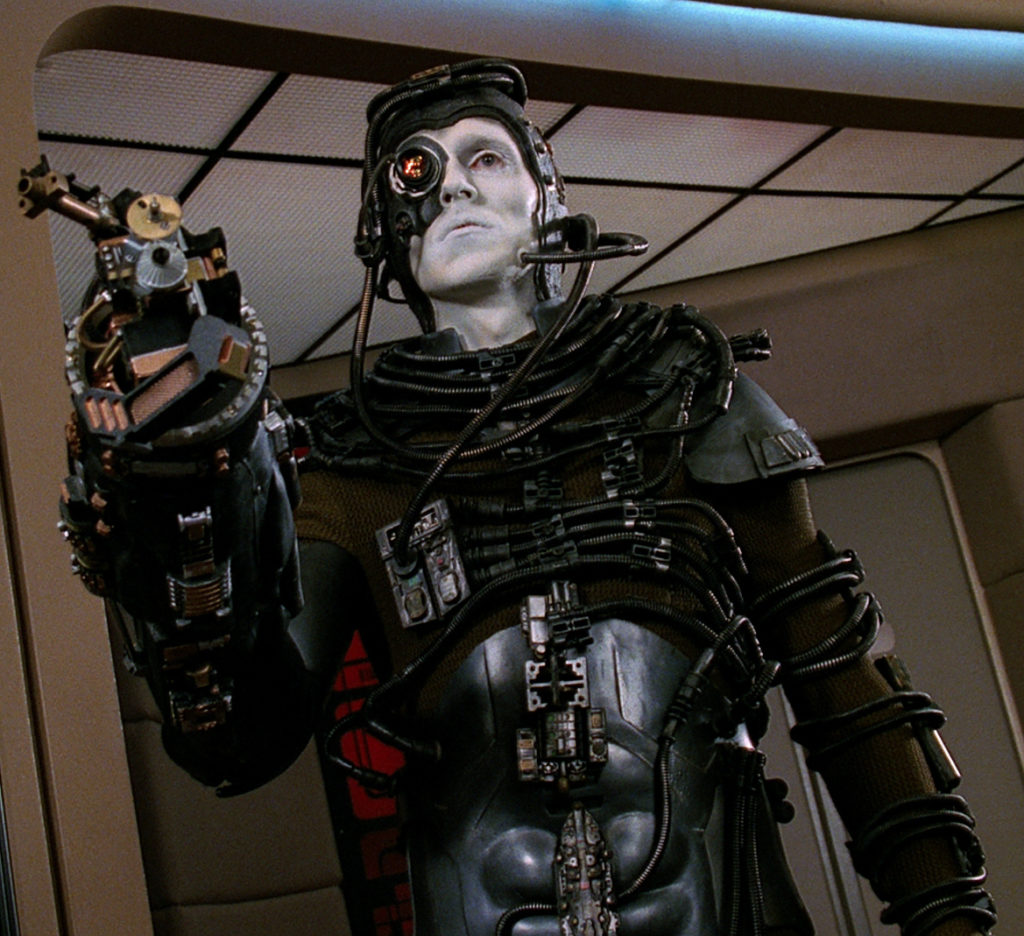
Serious as f**k.
Emotionless, seemingly unstoppable Geiger-zombies, the Borg collective represented the first truly terrifying threat to not just the Enterprise, but the entire Federation. The UFP had been threatened before, but this new species upped the stakes to the Nth degree, introducing a genuine element of horror.
An inter-connected species, they emerged at the very dawn of our digitally inter-connected society, playing upon our most primal technological fears. Introduced in the episode “Q-Who,” the Borg dramatically set up the series for greater things to come.
Every good show needs a good villain, and now, with a good villain, Star Trek: TNG became a good show. Their impact resonated throughout the rest of the series both directly and indirectly as they became the boogeyman lurking in the dark.
The original series never had such an oppressive element of danger, urgency and dread, and the Borg helped TNG attain a unique voice of its own without betraying any of the tenants that made TOS great (f**k you DS9).
By the time Picard utters “We have engaged…The Borg” in “The Best of Both Worlds,” we as an audience have been suitably primed.
The first episode won Emmy Awards for “Outstanding Art Direction for a Series” and “Outstanding Sound Editing for a Series”.[6]
The storyline appeared in TV Guide‘s “100 Most Memorable Moments in TV History” (July 1, 1996), ranked number 50. The episode was also ranked #70 on the 100 Greatest TV Episodes of All Time.[7] Part I was ranked No. 8 on the Top 10 Star Trek Episodes for the magazine’s celebration of the franchise’s 30th anniversary.[8]
In 2008, Empire magazine rated Star Trek: The Next Generation 37th on their list of “The 50 Greatest TV Shows of All Time” and cited “The Best of Both Worlds, Part II” as the show’s best episode.[9] The episode was ranked #36 on TV Guide‘s list of “TV’s Top 100 Episodes of All Time”.[10] The two-episode arc ranked second in Entertainment Weekly‘s list of top 10 Star Trek: The Next Generation episodes.[11] Starlog magazine listed the two part episodes as number three and four on their 25 top episodes of The Next Generation.[12]
Although the writers went to the well too many times following “The Best of Both Worlds” and greatly diminished their scare factor (“I am…Hugh”), the introduction of the Borg sparked the fanbase, silenced the nay-sayers and made even casual viewers sit up and take notice.
The “will-he-or-won’t-he-return” aspect of the Picard/Locutus season-ending cliffhanger – a first for Star Trek – was a stroke of genius. At the time, the fans went nuts (driven even crazier by reports of a serious contract dispute with Patrick Stewart) and honestly believed Picard could be lost.
Moore: What people forget now is in the first couple of seasons of Next Generation, we were sort of not taken seriously as Star Trek. The fans were split on the acceptance of the show. You would go to conventions and there would be bumper stickers and t-shirts that basically said, “I’m a real Trekker. Forget the bald guy.” Stuff like that. We were the second-tier Trek. When “Best of Both Worlds” came out, suddenly there was all this buzz. And it got in the press and there was all this tension and people were talking about the cliffhanger and Picard.
Jordan Hoffman, freelance writer/critic who specializes in Star Trek: After that “To be continued…” we felt, “Is Picard going to be killed?” After that episode, there was a lot of talk. Somehow we knew — there were rumors that Patrick Stewart was going to leave the show. That was definitely in the air. There would be somebody who goes, “You know Patrick Stewart is leaving?” How do you know this? “Everyone knows it.”
The ensuing tumult eventually got picked up by the mainstream media, creating a very loud buzz for TNG‘s fourth season. In the gap between seasons, the buzz only got louder, attracting the attention of everybody – fans, non-fans and former fans all now awaited the season premiere with baited breath. Would there be a new captain of the Enterprise?
This time, the show had its sh*t together, easily winning back many of the fans lost to the vomitous bile of the first two seasons. New viewers also flocked to the show, impressed by the creepy Borg and action-packed storyline. Ronald Moore recalled:
That was the turning point on Next Generation‘s acceptance as Star Trek, among the fans and with the public. Suddenly we had done something that was legitimate and got people’s attention and told a great story. From then on out we carried the torch. We were legitimate and that was the show that turned it around for us.
It wouldn’t be hyperbole to suggest the Borg saved TNG. Their ever-present threat created a legitimate sense of danger and excitement while continuing to shape the show in new and different ways – some mildly intriguing (“I, Borg”), some god-awful (“Descent I & II”).
The Borg also have the distinction of being the first serialized sub-plot of any consequence to be heavily foreshadowed (as mentioned in part one of this list, the “Invasion” arc was also foreshadowed). The Ferengi were mentioned before we ever saw them (if only they had remained off-screen), but it was the outpost “scooping” phenomena first mentioned in “The Neutral Zone” that kicked down the gates of Star Trek’s stand-alone format. A total accident, this little bit of heralding proved quite effective in teasing the Borg’s eventual introduction the following season.
1. The Judgment of the Q Continuum
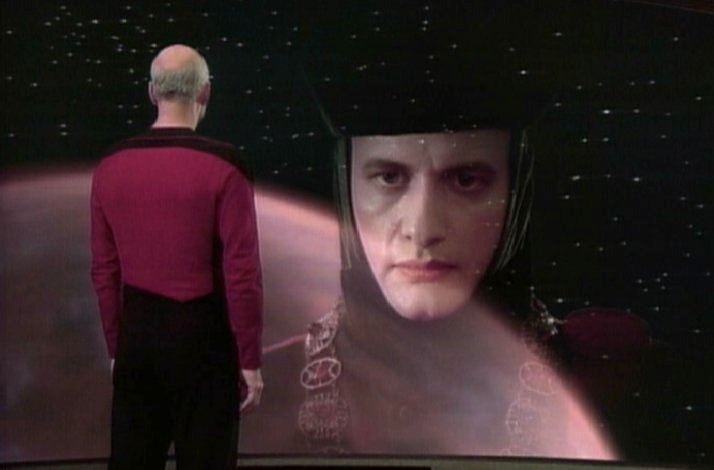
That rascal Q – introduced in the pilot “Encounter at Farpoint” – was originally an afterthought tacked onto the first episode’s plot to make the story longer. According to an oft-told Trek legend, Roddenberry was required to extend the pilot to two hours and in desperation fell back upon one of his favourite tropes: God in Human Form (used before in the TOS characters Apollo and Trellaine).
Originally a sort of cosmic judge and jury, Q was quite hostile and cold at first – more of a generic “alien of the week” kind of threat. In time he would evolve into a more comedic “trickster.”
Although the door was left open for further appearances, nobody knew at the time they were creating a thematic arc for the entire series that would effectively bookend the Enterprise-D’s small screen adventures.
When Q re-appeared in the abysmal and barftastic first season episode “Hide and Q,” he seemed destined to be nothing more than a two-episode recurring character, a la Harry Mudd. Truly unwatchable, the episode features Q losing a wager and promising never to again involve himself in humanity’s affairs.

Nevertheless, the writers said “F**k it, we’re out of ideas” and re-introduced Q once more in the second season episode “Q-Who,” beginning a mandatory inclusion of the character in almost every following season. Fortunately “Q-Who” was much, much better than Q’s previous appearances (largely thanks to the Borg).
The chemistry between Patrick Steward and John Delancie is undeniable, and several of the “Q” episodes are even quite good. Each succeeding appearance added more dimension and layers to both the character and his mysterious “continuum,” until his true motivations for harassing Picard and the Enterprise began to appear almost benign.
Or possibly sexually motivated.
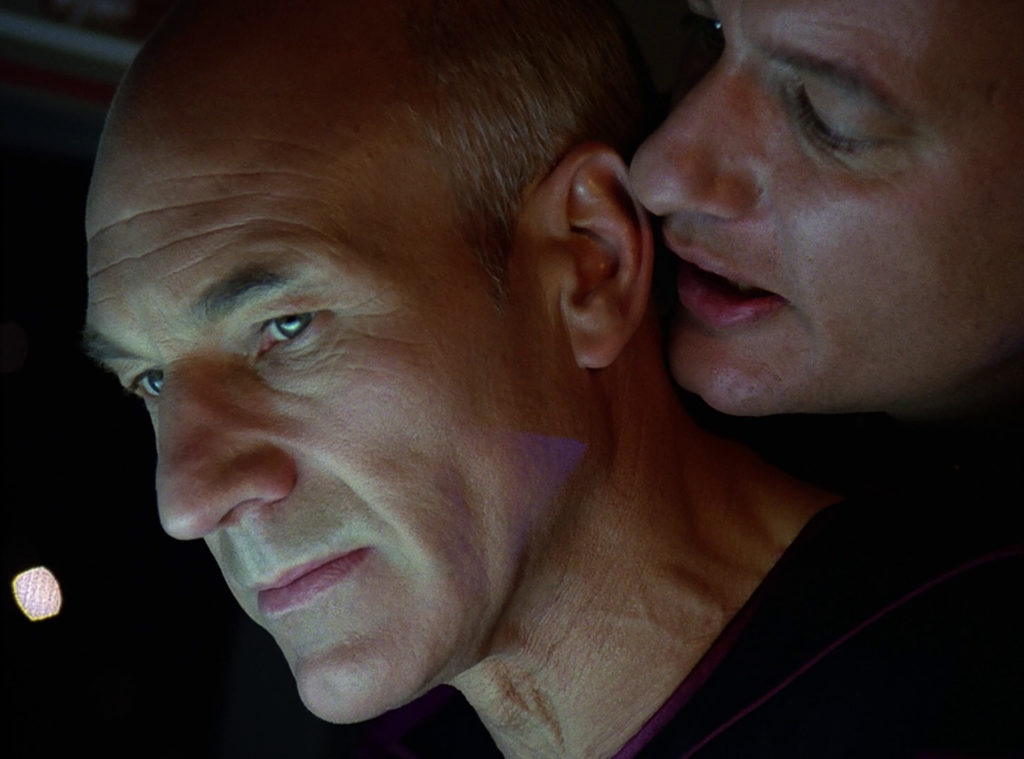
As with the Borg, the writers went back to the continuum’s well a few too many times, eventually making Q feel somewhat mundane. It wasn’t until the outstanding series finale “All Good Things…”, however, that the character of “Q” truly transcended his one-dimensional origins to bring it all home and neatly tie everything all together, essentially re-defining the over-arching theme of the entire series.
Born from desperation and refined and developed through repeated re-use, the inclusion of the Q continuum ended up re-framing the entire run of the show. The journeys of the Enterprise and her crew represented not just an exploration of the physical universe, but an exploration into the very nature of our existence and our ultimate role in the cosmos.
Um. Yeah. That makes it number one on this list.
“All Good Things…” won the 1995 Hugo Awardfor Best Dramatic Presentation,[5] and helped the show earn a 1994 Emmy nomination for Outstanding Drama Series.[2]
The episode ranked fifth in Entertainment Weekly‘s list of top 10 Star Trek: The Next Generation episodes.[6]USA Today called the two-part finale a “picture-perfect” ending to the series, giving it 3 1/2 stars out of 4.[7]
Later critical commentary has also been positive. Zack Handlen of The A.V. Club gave both parts of the two-hour finale an ‘A’ rating.[8] Writing for Tor.com, Keith DeCandido lauded the episode; comparing it favorably against other Star Trek series finales, he felt that “All Good Things…” is “the perfect ending to [The Next Generation]”, bringing events full circle back to series premiere “Encounter at Farpoint“, showcasing the talents of the entire cast, as well as keeping its optimistic “Roddenberrian view of humanity.”[9]
Ok, there you have it – all of the most important serialized arcs ranked and listed.
Considered but rejected and/or didn’t make the cut: Spot, Riker’s Libido, Deanna’s Promotion Quest, Moriarty, Minuet and Worf & Deanna’s Romance (barf).
Join us next time when I will be ranking every real animal that TOS and TNG ever brought on board the Enterprise. Number six will shock you!
For Odin! For honour! For the vanquishing of TERRIBLE!
I AM FERGUS THE JUSTIFIER!

